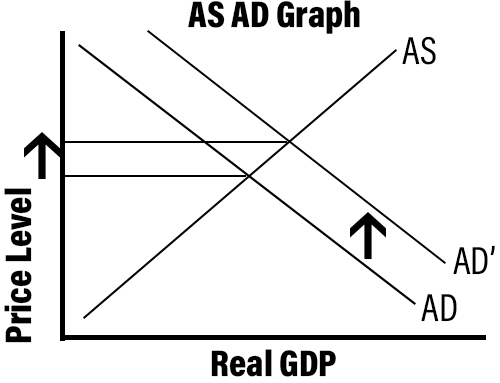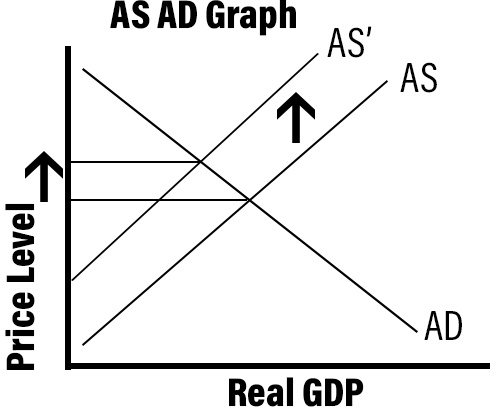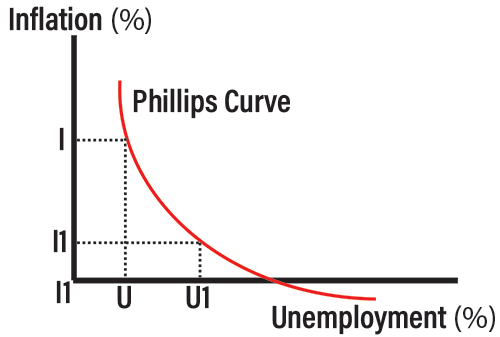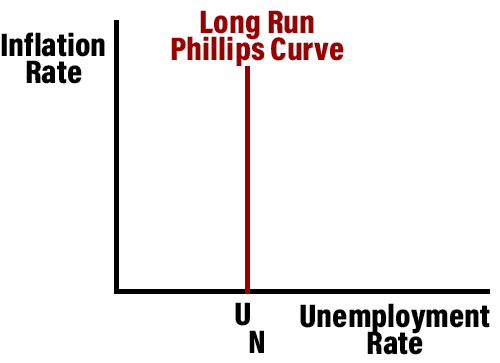Learn
Inflation
The easiest way to describe inflation is that you have too much money chasing too few goods and services. People who wonder why the government doesn't just print more money to help those in need do not realize that printing more money will actually make an economy worse. This type of inflation is called demand-pull inflation.
Expenditure Model and Inflation
Return for a moment back to the expenditure model you learned earlier:
GDP = C + I + G +/- Xn (a stable economy)
In an inflationary economy, the total spenders (aggregate demand) exceeds (greater than) total output (aggregate supply). Thus, the formula can be rewritten as follows:
GDP output < (is less than) C + I + G + Xn.
This can be caused by three types of inflation.
Demand-Pull Inflation and Hyperinflation
An economy that is suffering from demand-pull inflation means there is not enough output to meet the demand.
- This is "too much spending chasing too few goods."
- This results in a shortage of goods caused by the demanders pulling prices up.
- The spenders (C, I, G, Xn) want to buy goods and services but the shortage causes the prices to rise as they all compete to buy the limited output.
If the spending occurs in rampant out-of-control fashion, the nation suffers from hyperinflation.
Open Demand-Pull Inflation in a new tab
Answer the following quick questions:
- Which direction did the Aggregate Demand curves shift?
- What component of Aggregate Demand caused the shift?
- Does the shift of the AD curve mean more or less spending?
- Which direction did the Aggregate Supply curve shift?
- What happened to the price level?
- What type of inflation does this depict?
- What type of inflation occurs when the spending is out-of-control?
- In a macroeconomics graph, the vertical or y axis is not just prices, but ________Blank.
- In a macroeconomics graph, the horizontal or x axis is not just quantity but ________Blank.

Stagflation
Sometimes inflation occurs at the same time that the economic growth rate is stagnant or slows down; this situation is called stagflation. The term stagflation came into being during the 1973-1975 recession when there were six quarters in which the Gross Domestic Product got smaller.
This stagflation period was partially caused when oil exports to the U.S. were cut, causing prices for gasoline in the U.S. to quadruple.
In the 1970s, the nations that make up OPEC (Organization of Petroleum Exporting Countries) made an agreement to cut back on the production of oil, causing the price of oil to soar. Oil is such an important resource for every business and industry that the costs for all businesses increased, which resulted in higher price levels throughout the economy. This type of inflation is called cost-push inflation, the third type of inflation.
Cost-Push Inflation
An economy that is suffering from cost-push inflation means the suppliers are being pushed by the increasing costs of the resources/inputs they need to produce goods and services. The costs of land, labor, capital, and entrepreneurship are too high, so suppliers produce less.
Open Cost-Push Inflation in a new tab
Answer the following questions:
- Which direction did the Aggregate Supply curves shift?
- What caused the AS curve to shift to the left?
- Does the shift of the AS curve to the left mean more or less supply?
- Which direction did the Aggregate Demand curve shift?
- What happened to the price level?
- What type of inflation does this depict?
- In a macroeconomics graph, the vertical or y axis is not just prices, but _______Blank.
- In a macroeconomics graph, the horizontal or x axis is not just quantity but _______Blank.

Two General Types: Expected and Unexpected
Economists talk about two general types of inflation: expected inflation and unexpected inflation.
The expected rate of inflation for the United States in its recent history is 3 percent. With this expectation, it is easy for businesses to plan for future expansion or for consumers to make decisions about large purchases or careers.
Unexpected inflation is a general rise in price levels throughout the economy that no one is really prepared to handle. Unexpected inflation will cause problems for those most vulnerable in a society. Those with fixed incomes, or low incomes, will see more of their income used to buy the basic necessities of life.
Extreme and Hyperinflation
Extreme inflation is the worst type of inflation and has affected countries like Germany in the 1920s and Argentina around the 1980s.
Hyperinflation is inflation in the range of 500 percent a year and above. Hyperinflation, however, does not happen very often and generally is the last stage before a total monetary collapse.
Articles
Read the following two articles from NPR to learn more:
Consumer Price Index
A market basket is a basket of consumer goods used to calculate the Consumer Price Index (CPI) and is used to determine the level of inflation. The Bureau of Labor Statistics (BLS) is tasked with determining what goods and services will go into a representative market basket. For instance, the price of a can of Coca Cola will be included but not a can of a generic brand.
The BLS will also give a weight to certain items in the basket. This is done because an increase in the price of houses, for example, would tend to hurt the consumer more than a price increase in clothing.
Since there is subjectivity in what is placed in the market basket, and there is importance assigned to each item, the CPI is often criticized for not being representative of the true price level.
To illustrate how the government determines CPI, we will use a simplified basket containing just a few items. While the BLS basket contains almost 80,000 items, for practical purposes our basket will only contain three items: shirts, gas and food. The price of each basket with the prices for 2010 and 2011 are listed below.
| Item | Quantity | 2010 | Total Cost 2010 | 2011 | Total Cost 2011 |
|---|---|---|---|---|---|
| Shirts | 5 | $10 | $50 | $12 | $60 |
| Gas | 10 | $20 | $200 | $19 | $190 |
| Food | 50 | $3 | $150 | $4.50 | $225 |
| TOTAL | $450 | $475 |
Cost of the Market Basket
We can now determine the cost of the market basket for each year.
In 2010, the total basket cost:
$50(5×10) + $200(10×20) + $150(5×30) = $400
The same basket, with the exact same items, in 2011 cost:
$60(12×5) + $190(19×10)+ $225(4.50×50) = $475
Calculating CPI
We will now choose our base year. In this case, we will choose 2010.
To determine the CPI, we take the price of the basket divided by the price of the basket in the base year and multiply by 100.
For 2010, CPI would be:
(400/400) × 100 = 100
This shows how the base year CPI is always 100.
To calculate the CPI for 2011, the equation would look like:
(475/400) × 100 = 118.75
To calculate the increase in CPI, or the increase in the price level we will use the rate of change formula:
(New − Old) / Old × 100
In this case price level increased 475−400 / 400×100 = 18.75 percent. This simply means the same basket of goods now costs 18.75 percent more.
Real GDP vs. Nominal GDP
As a quick reminder:
- Nominal GDP uses current prices to value the economy's production of goods and services. Nominal includes inflation.
- Real GDP uses constant base-year prices to value the economy's production of goods and services. Real excludes inflation.
Recall from your earlier study of GDP that, in order to compare a nation's wealth with another country, we need to calculate a nation's Real GDP output.
Apply this economic measurement to your own grades. Your core GPA is more indicative of your academic success than your overall GPA, which includes "easy" electives that inflate or overestimate your academic success.
Inflation Calculator
Let's use the US Inflation Calculator see how the value of money has changed! Use it to answer the following:
- If it costs Cheryl $11.00 for a new putter in 1976, what the golf club cost in today's dollars?
- If your grandmother paid 25 cents to see Gone With The Wind in 1938, what would she be paying in today's dollars?
- Congrats! You just received a $100 check from Aunt Sally for graduation this year. If you graduated in 1950, what would the $100 check be equivalent to today?
- If your mother earned 50 cents an hour babysitting in 1972, what would that be worth in today's dollars?
Phillips Curve
There is a relationship between inflation and unemployment. The relationship was recognized and depicted graphically by economist A.W. Phillips. The Phillips Curve suggests in the short run (graph 1 below), there is a short run tradeoff between inflation and unemployment.
- This means we usually have one or the other, not both.
- A nation that is affected by both suffers from stagflation.
In the long run, (graph 2 below), there is no trade-off between inflation and unemployment.

